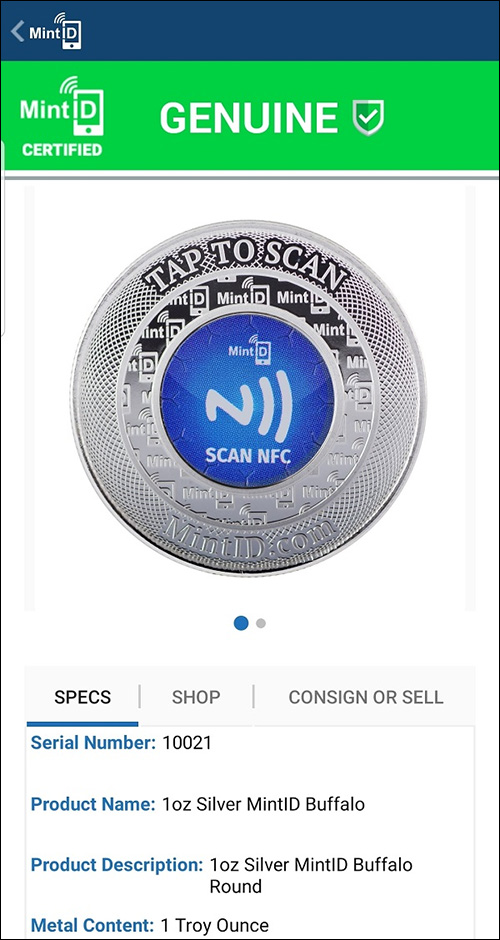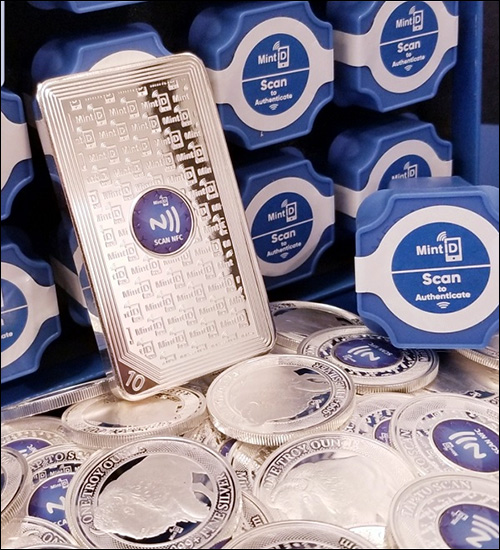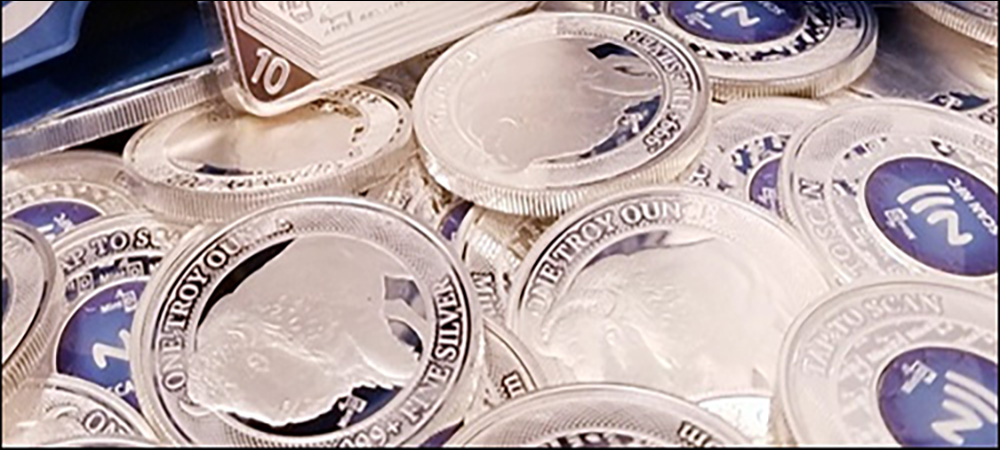Precious metal investment company MintID is offering a technology-based solution to help retailers and collectors ensure the authenticity of the silver or gold coins or bullion products they purchase or sell. The solution employs Near Field Communication (NFC) chips from Identiv, using MintID’s secure AES-128-bit encryption protocol, as well as MintID’s own software platform and Android- and iOS-based mobile app.
The solution is aimed at thwarting counterfeiting by providing buyers with proof of authenticity for their purchases. An NFC chip built into any of the company’s precious metal products allows app users to authenticate their purchases. Users who tap on the chip with an NFC-enabled phone can thereby be instructed that the product they have purchased is the real thing, according to Corey Maita, MintID’s founder.

A buyer can download the app and utilize the technology to ensure the authenticity of purchases.
Retailers such as JM Bullion sell MintID products with the authentication technology. For instance, if a buyer purchases an American Gold Buffalo coin, which costs approximately $1,850, the coin comes permanently encased in a card with a unique digital identity that can be accessed via a smartphone. Within the next month, the company also intends to release a version of the NFC solution for use with luxury goods, known as InstantlyID.
Maita co-founded a precious metals retail company while in college in 2007, after which he became Spectrum Group’s VP of business development. “One of the biggest concerns from buyers,” he says, “was ‘How do I know what I’m buying is actually real?'” Often, he explains, “People are investing their retirement money. A lot of what we do goes into precious metal IRAs… so people want to know what they invest in is genuine.”
Despite the high value of the products being bought and sold, Maita says, there is little supply chain visibility into the location and status of goods, meaning that individuals could introduce counterfeits before a product reaches the customer. “There’s no supply chain tracking of precious metals,” he states. “I’ve always been looking for a way to solve that challenge for our customers.” MintID addresses this problem, he says, by embedding the NFC chips directly at MintID-certified mints.
The company began looking at the few authentication solutions available, such as QR codes, barcodes or holograms, but such solutions systems left the potential for fraud. NFC, on the other hand, would allow each MintID product to be securely tracked with AES-128-bit encryption technology, which he says has been the U.S. government’s standard for protecting top-secret information since 2002. This year, the company has developed its system with the Identiv chip built between the layers of plastic in a gold or silver coin’s card. MintID’s system can also be attached directly to the precious metal, at the point at which the products are created at minting agencies.
The 13.56 MHz RFID tags comply with both the NFC ISO 14443 and HF ISO 15693 standards. They come in two versions: a tamper-proof label that is attached directly to gold and silver bullion, as well as a tag built into the paper card encasing a coin. The tamper-proof on-metal tags come with built-in shielding technology to ensure they will operate well when applied to metallic surfaces, according to Stephane Ardiley, Identiv’s director of product management. For 1-ounce and 10-ounce gold and silver products, on-metal tags specially engineered for read range and usability are adhered into the recessed surface of the gold or silver.
Identiv custom-engineered an on-metal RFID tag that would operate well when embedded directly into a precious metal coin, Ardiley explains. “We had to design something very specific,” he says. “We didn’t want it to be too visible or too cumbersome” for the product. It has a diameter of 18 millimeters (0.7 inch). The label is also encased in plastic for further protection, requiring customization to ensure it can be properly read through the encasing.
Identiv advised using the latest version of NXP‘s NTAG inlays, the NTAG Crypographic AES 128 chip. With the new system, when silver or gold is minted, it is assigned an RFID tag with a unique ID number encoded on it, and that ID is stored with the item’s serial number in MintID’s database. MintID, in fact, built an Internet of Things (IoT) software platform and encryption protocol to provision each chip. That process, Maita says, “was the biggest challenge to all of this.”

Customers who buy a coin or other product can download the MintID Apple or Android app, then tap their smartphone against the product or its card and identify that it is, indeed, a MintID product. A user can register the product or authenticate purchases anonymously. In many cases, owners prefer to remain anonymous for security purposes. The app displays related content, such as an image of the coin and its specifications, including its size, weight, mold content, diameter and unique serial number. A user can also view the product’s value at any time by tapping the phone against the card twice, which will produce a free quote.
In addition, the app can be used if the owner wishes to sell the coin or bar. The user would tap the phone against the tag and select the prompt to sell the item. The collector would then be contacted by a retailer to begin the sales process. If the coin is sold at a show or other private sale, the buyer can similarly download the app and utilize the technology to ensure authenticity.
“I scoured the world looking for the right company” to provide the RFID chips and software platform on which the MintID system is built, Maita says. However, he adds, he was not impressed with the solutions available. “The obstacle was that people could build chips but no platform, or no encryption—nothing was plug-and-play. People who said they could do it actually couldn’t do it.” MintID found that Identiv offered the best custom-designed product, he recalls.
MintID built the encryption piece, the platform and its own apps. Within the next month, the company plans to release the InstantlyID platform with chips designed for a a variety of products. InstantlyID will be a broader-reaching solution, Maita says, providing authentication and “connecting buyers with truly unique marketing experiences built directly within the InstatlyID IoT platform.” He says the platform can be used to authenticate any products that benefit from anticounterfeiting and marketing solutions.
To date, Maita reports, MintID has found that buyers are already using the technology, based on access to the app. “We’re seeing that people are scanning the tags” to provide authentication, he says.


